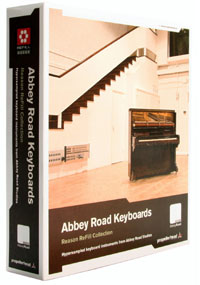 Abbey Road Studios and Propellerhead Software have announced that they have partnered to produce the Abbey Road Keyboards ReFill for Propellerhead Software’s Reason.
Abbey Road Studios and Propellerhead Software have announced that they have partnered to produce the Abbey Road Keyboards ReFill for Propellerhead Software’s Reason.
Abbey Road Keyboards delivers a hypersampled collection of seven unique instruments, recorded using the original equipment at the legendary Abbey Road Studios.
The Abbey Road Keyboards ReFill consists of Reason 3.0 patches with samples of Steinway “Mrs. Mills” piano, Challen studio piano, Hammond RT-3 & Leslie Model 122, Mannborg Harmonium, Mellotron Model 400, Schiedmayer Celeste and Premier Tubular Bells. These keyboards have been at the studios since the early 60’s and were used on some of the most popular tracks of all time—from A Hard Day’s Night to Dark Side Of The Moon as well as numerous film scores such as Raiders of the Lost Ark, Aliens, all three Lord of the Rings movies and Harry Potter and the Prisoner of Azkaban, to name but a few.
Abbey Road Keyboards was recorded in the famed Studio Two, where The Beatles recorded almost all of their songs. It is a spacious recording room, with a 28′ high ceiling and over 2,280 square feet of space. Its acoustics are meticulously tuned with suspended bass traps, hanging quilted curtains and four 10′ by 20′ acoustically-treated panels that swing out from the walls to temporarily reduce the total room size. Not only was Abbey Road Keyboards sampled using state-of-the-art equipment and techniques from this studio, Propellerhead Software consulted with senior Abbey Road engineers to also capture these instruments as they were back in the day, incorporating some of the same vintage microphones, preamps, outboard processors and mixing consoles.
All instruments were captured using Propellerhead Software’s Hypersampling method. To capture every aspect of the instruments – from the way they resound in the Studio Two to their unique timbres and characteristics – they were all recorded at multiple velocity levels, from multiple angles, using multiple sets of microphones through the original mics, preamps, consoles and outboard gear at Abbey Road. With all the mic signals available separately in Reason, the Abbey Road Keyboards user can select between vintage sounding combinations of mics and pre-amps or state-of-the-art clean recordings, ready for the user’s own preferred processing.
The Abbey Road Keyboards ReFill will be available from Propellerhead dealers worldwide on June 13 2007. MSRP is EUR €199 / USD $229.
The instruments in detail:
- Steinway Vertegrand “Mrs. Mills” piano: Manufactured in Hamburg, Germany in 1905 by Steinway & Sons, this exquisite piano has been tuned in a way that makes it sound out of tune—but in a very pleasant way, like some beaten-up barroom piano only better. Thanks to its lacquered hammers, the “Mrs. Mills” piano produces a bright, cut-through-the-mix sound and responds very dynamically to varying note velocities.
- Challen studio piano: Sounding more like a typical home piano than the Steinway, the Challen piano offers a warm tone along with an unusually long sustain in its notes.
- Hammond RT-3 & Leslie Model 122: The RT-3 is much bigger and heavier than the familiar big and heavy Hammond B. Besides the organ, there’s one other crucial item necessary for the full and proper effect: a Leslie 122 speaker. The talented Hammond organist Peter Adams played on the sessions to help capture many combinations the Hammond-and-Leslie sound.
- Mannborg Harmonium: The Mannborg Harmonium is a foot-pedaled organ that sucks air through the reeds when pumped with the pedals. This Harmonium could qualify as the first instrument with a split keyboard; keys on the left side of the split point play a different group of reeds than those on the right. This split feature is maintained in the Harmonium presets.
- Mellotron Model 400: The Mellotron Model 400 qualifies as one of the earliest sample players, except that instead of having RAM chips full of sounds inside, its samples have been recorded on 6′ long strips of 3/8″ magnetic tape. Abbey Road Keyboards features the samples of the Cello, Strings and Flute tapes.
- Schiedmayer Celeste: The Celeste is like an overgrown glockenspiel, played with piano style keys. It produces soft and warm, bell-like timbres. Historically speaking, a Celeste has most often been used within orchestral contexts, however many Abbey Road artists have Premier Tubular Bells: The Tubular Bells is an orchestral percussion instrument made up of hollow metal tubes mounted on a frame. It’s tuned and laid out like a keyboard instrument and played by striking it with rubberized hammers. Who would use tubular bells, known as orchestral chimes, in a pop song? The Beatles, for one. Listen to “You Never Give Me Your Money” or “When I’m 64”.
Product features
- Abbey Road Keyboards is a two DVD set containing both 16-bit and 24 bit versions of the sound library. The 16-bit version is lighter on the CPU and is suitable for composing and production work, while the 24-bit version is good to use at final mixing. The two are easily interchanged.
- The ReFill also includes Guide To Abbey Road Keyboards, a 40-page full color booklet by Mark Vail (the author of Vintage Synthesizers and The Hammond Organ). The booklet provides a behind-the-scenes look at the ReFill recording sessions, the mics and outboard gear used and the instruments themselves.
